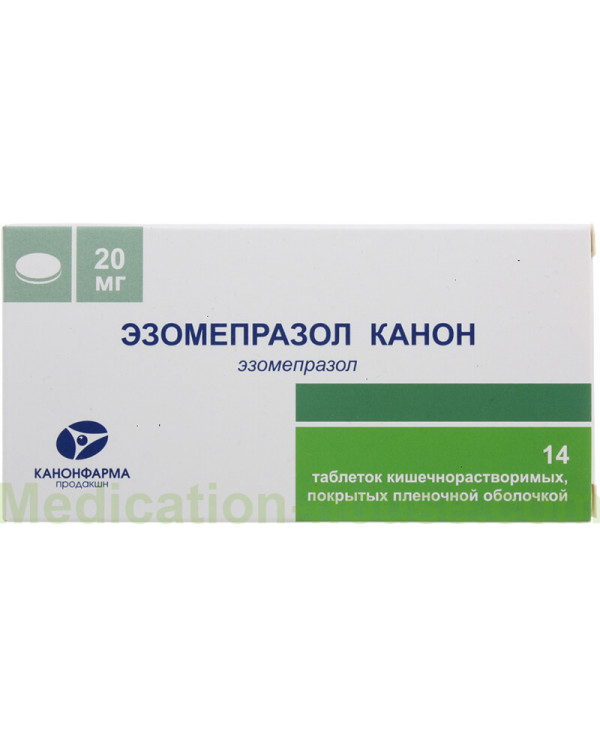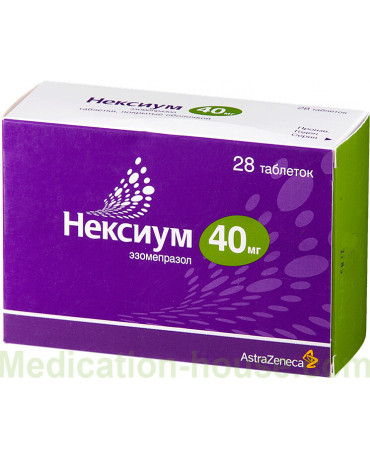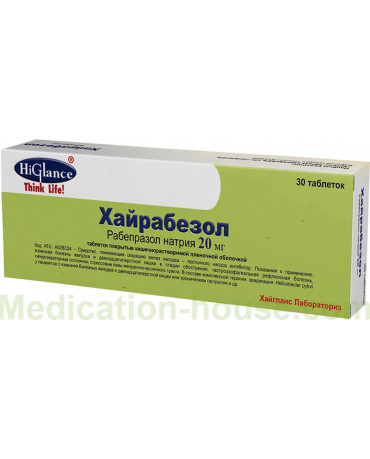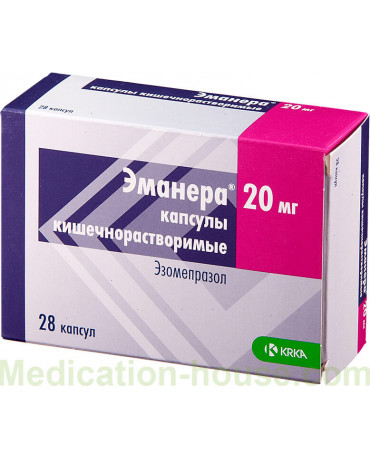Instruction for Esomeprazole
You can buy Esomeprazole here
Release form and composition
The appearance, composition of excipients of the drug and its packaging may differ from manufacturer to manufacturer. Below is a description using the example of Esomeprazole, produced by the pharmaceutical company RUE "Belmedpreparaty".
Dosage form - enteric-coated tablets: oblong; 20 mg - light pink with "CE" engraved on one side and "20" on the other; 40 mg is pink with CE engraving on one side and 40 on the other. Packed in 7 pcs. in blisters, 2 or 4 packs are placed in a cardboard box, or 10 pcs. in blisters, 1, 2 or 3 packages are placed in a cardboard box, or 7, 24 or 100 pcs. in plastic bottles / jars.
Composition of 1 tablet:
active ingredient: esomeprazole (in the form of magnesium trihydrate) - 20 or 40 mg;
additional substances: polysorbate 80 (E433), macrogol 400, crospovidone (E1202), methacrylic acid and ethyl acrylate copolymer (1: 1), macrogol 6000, powdered sugar, sugar spheres, hypromellose phthalate, colloidal silicon dioxide (E551), cellulose microcrystalline E460), light magnesium oxide, glycerin monostearate 40-55, hydroxypropyl cellulose (E463), povidone, talc, pregelatinized starch, iron oxide red (E172);
shell composition: macrogol (polyethylene glycol 400), lactose monohydrate, in 20 mg tablets - pink opadry 03B84893 [titanium dioxide (E171), hydroxypropyl methylcellulose (E464), macrogol 400, iron oxide yellow (E172), iron oxide red (E172)], in tablets 40 mg - pink opadry 03B54193 [titanium dioxide (E171), hydroxypropyl methylcellulose (E464), macrogol 400, red iron oxide (E172)].
Pharmacodynamics
The drug is the S-isomer of omeprazole. The substance has the ability to reduce the basal and stimulated secretion of acid in the stomach, which is due to the specific inhibition of the proton pump in parietal cells.
Mechanism of action
Esomeprazole is a weak base that accumulates in the secretory tubules of parietal cells in an acidic environment, where it activates and inhibits the H + / K + -ATPase enzyme - the proton pump.
Effect on gastric acid secretion
The drug begins to act within 1 hour after ingestion of a dose of 20 or 40 mg. In the case of regular intake of esomeprazole in a daily dose of 20 mg for 5 days, the average maximum acid concentration after stimulation with pentagastrin decreases by 90% (the measurement was made on the 5th day of therapy, 6-7 hours after taking the drug).
In patients with gastroesophageal reflux disease (GERD) with clinical symptoms after 5 days of regular oral administration of the drug at a dose of 20 or 40 mg per day, the intragastric pH value above 4 was maintained for 13 and 17 hours. When taking the drug in a daily dose of 20 mg, this value was maintained for at least 8 hours in 76% of patients, 12 hours - in 54%, 16 hours - in 24%, when taking esomeprazole at a dose of 40 mg - respectively in 97%, 92% and 56 %.
A correlation (relationship) was established between the plasma concentration of esomeprazole and the inhibition of acid secretion (in accordance with the AUC parameter - the area under the concentration-time curve).
Action in inhibiting acid secretion
Due to the inhibition of acid secretion with regular administration of the drug in a daily dose of 40 mg, reflux esophagitis heals in about 78% of patients after 4 weeks of treatment, in 93% after 8 weeks.
The use of esomeprazole in a daily dose of 40 mg (2 times a day, 20 mg) in combination with antibiotic therapy for 1 week in 90% of patients leads to the successful eradication of the Helicobacter pylori bacteria. In case of uncomplicated peptic ulcer disease after a 7-day course of treatment, no further monotherapy with antisecretory drugs is required to eliminate symptoms and heal the ulcer.
Other effects associated with inhibition of acid secretion
Antisecretory drugs reduce acid secretion, as a result of which the level of gastrin in the plasma increases. In patients receiving esomeprazole for a long time, the number of enterochromaffin-like (ECL) cells increases, which is probably associated with an increase in plasma gastrin levels. Due to the decrease in acidity, an increase in the amount of chromogranin (CgA) is also noted.
In patients receiving antisecretory agents for a long time, the formation of glandular cysts in the stomach is more often diagnosed, which is due to physiological changes due to pronounced inhibition of acid secretion. The cysts are benign and reversible.
There were two comparative studies on the use of ranitidine and esomeprazole, where the latter showed a higher efficiency in the healing of gastric ulcers that developed as a result of the use of non-steroidal anti-inflammatory drugs (NSAIDs), including selective inhibitors of cyclooxygenase-2.
When conducting comparative studies with placebo, the best efficacy of esomeprazole in preventing the formation of gastric and duodenal ulcers in patients over 60 years of age and / or with a history of peptic ulcers who received NSAIDs was noted.
Pharmacokinetics
Esomeprazole is unstable in an acidic environment, therefore it is produced in the form of tablets containing granules of the drug and coated with a shell that is resistant to the action of gastric juice. Under in vivo conditions, it was found that only a small part of esomeprazole is converted to the R-isomer.
The drug is rapidly absorbed and reaches its maximum plasma concentration after 1–2 hours.
After a single dose of 40 mg, the absolute bioavailability of the substance is 64%, with regular intake once a day, this figure increases to 89%. When taking a dose of 20 mg, these coefficients are 50% and 68%, respectively.
Esomeprazole is characterized by high protein binding - about 97%. The volume of distribution at equilibrium concentration in healthy volunteers is approximately 0.22 l / kg body weight.
Simultaneous food intake slows down and reduces the absorption of esomeprazole in the stomach, but does not significantly affect the process of inhibiting the secretion of hydrochloric acid.
Metabolism and excretion
The drug is metabolized with the participation of the cytochrome P450 (CYP) system, the main part - with the participation of the specific polymorphic isoform CYP2C19, as a result of which hydroxy- and demethylated metabolites are formed, the rest - with the participation of the CYP3A4 isoform, as a result of which the sulfo-derivative esomeprazole is formed - the main metabolite, determined plasma.
The following are parameters that mainly reflect the nature of the pharmacokinetics of esomeprazole in patients with an active metabolism (active enzyme CYP2C19).
Total clearance: after a single dose - 17 l / h, after multiple doses - 9 l / h.
The half-life with regular administration of the drug once a day is 1.3 hours.
With repeated admission, the AUC increases. Its dose-dependent increase in this case is non-linear due to a decrease in metabolism during the "first pass" through the liver and a decrease in systemic clearance, presumably caused by inhibition of the CYP2C19 enzyme. Esomeprazole does not possess cumulative properties and is completely excreted in the intervals between doses 1 time per day.
The main metabolites of esomeprazole have no effect on gastric acid secretion.
The drug is excreted in the form of metabolites: up to 80% of the dose taken - with urine, the rest - with feces. Less than 1% is found unchanged in urine.
Features of pharmacokinetics in certain groups of patients
After a single dose of esomeprazole at a dose of 40 mg, the average AUC in women is 30% higher than in men. With repeated use of the drug once a day, there are no differences in pharmacokinetics depending on gender. This feature does not affect the recommended dose and route of administration of esomeprazole in men and women.
In about 2.9% ± 1.5% of the population, the CYP2C19 enzyme is inactive (inactive metabolism), therefore, the metabolism of esomeprazole occurs with the participation of the CYP3A4 isoenzyme. In patients who systematically take the drug at a dose of 40 mg 1 time per day, the average AUC is 100% higher than in patients with rapid metabolism (active CYP2C19 enzyme), and the average maximum plasma concentrations are increased by about 60%. These features do not affect the recommended doses and the way of using the drug in patients with a fast and inactive metabolism.
In adolescents aged 12 to 18 years after repeated administration of the drug (at a dose of 20 or 40 mg), the time to reach the maximum plasma concentration and AUC values are similar to those in adults.
In elderly patients aged 71 to 80 years, significant changes in the metabolism of esomeprazole were not observed.
With mild to moderate hepatic impairment, a violation of the metabolism of esomeprazole is possible. It has been established that in patients with severe hepatic insufficiency, the metabolic rate decreases, as a result of which the AUC value of the drug increases 2 times, therefore, for them the daily dose should not exceed 20 mg. With a single dose, esomeprazole is not cumulated.
In patients with renal insufficiency, the pharmacokinetics of the drug have not been studied. Given the fact that it is not esomeprazole itself that is excreted through the kidneys, but its metabolites, it is expected that the metabolism of the drug does not change in renal failure.
Indications for use
Adults
symptomatic treatment of GERD (gastroesophageal reflux disease);
therapy of erosive reflux esophagitis;
long-term maintenance therapy after healing of erosive reflux esophagitis to prevent its recurrence;
eradication of Helicobacter pylori bacteria in peptic ulcer disease, including prevention of recurrence of peptic ulcer associated with Helicobacter pylori (as part of combination therapy);
peptic ulcer and 12 duodenal ulcer, including associated with the use of non-steroidal anti-inflammatory drugs (NSAIDs), including prophylaxis in patients who take NSAIDs for a long time and are at risk;
Zollinger-Ellison syndrome;
other conditions characterized by pathological hypersecretion, including idiopathic hypersecretion.
Teenagers from 12 years old
symptomatic therapy for GERD;
duodenal ulcer associated with Helicobacter pylori;
treatment of erosive reflux esophagitis;
long-term maintenance therapy after healing of erosive reflux esophagitis to prevent its recurrence.
Contraindications
hereditary fructose intolerance, glucose-galactose malabsorption, sucrose-isomaltase deficiency;
age up to 12 years;
lactation period;
hypersensitivity to any component of the drug (active or auxiliary) or other substituted benzimidazoles.
The drug should be used with caution during pregnancy.
Instructions for use: method and dosage
The drug is indicated for oral administration. The tablets should be swallowed whole (not crushed or chewed) and washed down with a sufficient amount of liquid. Patients who have difficulty swallowing are allowed to dissolve the tablet in ½ glass of still drinking water, stir thoroughly until the tablet disintegrates, drink the suspension of microgranules, fill the glass halfway with water, stir the rest and drink. Liquids other than ordinary water should not be used as they may affect the state of the containment shell of the microbeads. Do not crush or chew microgranules. The prepared suspension is usable for no more than 30 minutes.
For patients who cannot swallow the tablets, they can be dissolved in still water and administered through a nasogastric tube. In this case, an important condition is thorough preliminary testing of the selected syringe and probe.
Recommended dosing regimens for adults according to indications:
treatment of erosive reflux esophagitis: 40 mg 1 time per day for 4 weeks. If healing does not occur, or symptoms persist, an additional 4-week therapy is possible;
long-term supportive treatment to prevent recurrence of erosive reflux esophagitis after healing: 20 mg once a day;
symptomatic therapy for GERD: 20 mg 1 time per day for 4 weeks. If after this period the symptoms persist, additional examination of the patient is required. After relief of symptoms, it is possible to switch to taking the drug in the "as needed" regimen, that is, 20 mg 1 time per day in case of recurrence of symptoms (this regimen is not recommended for patients at risk of peptic ulcer disease and taking NSAIDs);
duodenal ulcer associated with H. pylori: 20 mg of esomeprazole in combination with clarithromycin 500 mg and amoxicillin 1000 mg. All drugs are taken 2 times a day in a 7-day course;
prevention of recurrence of peptic ulcer associated with H. pylori: 20 mg of esomeprazole in combination with clarithromycin 500 mg and amoxicillin 1000 mg. All drugs are taken 2 times a day in a 7-day course;
treatment of stomach ulcers associated with the use of NSAIDs: 20 mg 1 time per day for 4–8 weeks;
prevention of duodenal ulcer and stomach ulcer when using NSAIDs: 20 mg 1 time per day;
Zollinger-Ellison syndrome and other conditions with pathological hypersecretion: 40 mg 2 times a day, the further dose and duration of treatment are selected individually, depending on the clinical picture of the disease. There is experience of taking esomeprazole in daily doses up to 160 mg. If a dose above 80 mg is indicated, it should be divided into 2 doses.
For adolescents over 12 years of age with a duodenal ulcer caused by Helicobacter pylori, the drug is prescribed in combination with antibacterial drugs, under the supervision of a specialist.
Average doses of medicines depending on the patient's weight:
body weight 30–40 kg: 20 mg esomeprazole, 750 mg amoxicillin and 7.5 mg / kg clarithromycin. All drugs are taken 2 times a day for 7 days;
body weight over 40 kg: 20 mg of esomeprazole, 1000 mg of amoxicillin and 500 mg of clarithromycin. All drugs are taken 2 times a day for 7 days.
Side effects
The following side effects were reported in post-marketing studies and did not depend on the dose of the drug, they are classified according to the frequency of development: very often -> 1/10, often - from> 1/100 to <1/10, infrequently - from> 1/1000 to <1/100, rarely - from> 1/10 000 to <1/1000, very rarely - <1/10 000, unknown - these phenomena are not described in the available literature:
from the nervous system: often - headache; infrequently - dizziness, drowsiness, paresthesia; rarely - changes in taste;
from the gastrointestinal tract: often - abdominal pain, flatulence, diarrhea, constipation, nausea, vomiting; infrequently - dry mouth; rarely - stomatitis, gastrointestinal candidiasis; unknown - microscopic colitis;
from the side of the psyche: infrequently - insomnia; rarely - agitation, anxiety, depression; very rarely - aggression, hallucinations;
from the side of metabolism and nutrition: infrequently - peripheral edema; rarely, hyponatremia; unknown - hypomagnesemia, including severe, combined with hypocalcemia;
from the hepatobiliary system: infrequently - an increase in liver enzymes; rarely - hepatitis (including jaundice); very rarely - liver failure, hepatic encephalopathy;
on the part of the blood and lymphatic system: rarely - thrombocytopenia, leukopenia; very rarely - agranulocytosis, pancytopenia;
on the part of the musculoskeletal system: infrequently - fractures of the hip, wrist, spine; rarely - arthralgia, myalgia; very rarely - muscle weakness;
from the respiratory system: rarely - bronchospasm;
from the side of the kidneys: very rarely - interstitial nephritis;
from the reproductive and genital spheres: very rarely - gynecomastia;
from the immune system: rarely - fever, anaphylactoid reactions, allergic reactions, angioedema, shock;
from the organs of hearing and vision: infrequently - vertigo; rarely - blurred vision;
on the part of the skin and subcutaneous tissue: infrequently - itching, rash, urticaria, dermatitis; rarely - alopecia, photosensitivity; very rarely - Stevens-Johnson syndrome, exudative erythema multiforme, toxic epidermal necrolysis;
others: rarely - sweating, discomfort.
Overdose
To date, only a few cases of deliberate overdose are known. When taking the drug in a dose of 280 mg, general weakness and symptoms from the digestive system arose. With a single dose of 80 mg, there were no negative effects. The specific antidote for esomeprazole is unknown. Dialysis is ineffective because the drug binds to plasma proteins. Overdose treatment is symptomatic and supportive.
Special instructions
Esomeprazole can mask the symptoms of a malignant neoplasm in the stomach, therefore, if any alarming symptom appears (spontaneous loss of body weight, dysphagia, melena, repeated vomiting or vomiting with blood), additional examination should be carried out.
Patients taking the drug "as needed" should be warned about the need to immediately consult a doctor if the nature of the symptoms changes.
With long-term treatment (especially more than a year), careful monitoring of the patient's condition is required.
When prescribing Esomeprazole in combination with antibacterial therapy for the eradication of Helicobacter pylori, contraindications and the likelihood of drug interactions of all drugs must be taken into account.
Like other proton pump inhibitors, esomeprazole can cause gastrointestinal infections associated with Campylobacter and Salmonella. The drug is not recommended to be used in combination with atazanavir / ritonavir. If treatment with such combinations is justified, the patient should be monitored when prescribing a dose of 400 mg atazanavir / 100 mg ritonavir; Esomeprazole 20 mg should not be ruled out.
Esomeprazole inhibits CYP2C19, which should be taken into account when prescribing drugs that are metabolized by this enzyme. The occurrence of drug interactions with the use of omeprazole and clopidogrel has been established, therefore, these combinations should be avoided for safety reasons.
If a laboratory test is prescribed to determine the level of CgA in neuroendocrine tumors, the drug should be canceled 5 days before the study.
In older people, long-term use of proton pump inhibitors increases the risk of fractures of the wrist / hip / spine by 10-40%, therefore, patients with osteoporosis are shown additional prescription of calcium and vitamin D.
Some patients receiving proton pump inhibitors for an extended period (3–12 months) have severe hypomagnesemia. Its symptoms are: dizziness, fatigue, delirium, convulsions, ventricular arrhythmia. In most cases, these symptoms resolve after discontinuation of esomeprazole or administration of magnesium preparations.
In patients taking esomeprazole for a long time in combination with digoxin or diuretics, hypomagnesemia may develop, therefore, in this case, monitoring of the level of magnesium in the blood is required.
Esomeprazole may reduce the absorption of vitamin B12 (cyanocobalamin) due to hypo- or achlorhydria, which should be considered in long-term treatment of patients with risk factors for decreased absorption of vitamin B12.
Influence on the ability to drive vehicles and complex mechanisms
Esomeprazole has no properties that would negatively affect a person's ability to concentrate, the speed of his mental and physical reactions.
Application during pregnancy and lactation
In experimental studies on animals, no negative effects of esomeprazole on the development of the embryo / fetus have been identified. With the introduction of a racemic substance, there was also no negative effect on the course of pregnancy and childbirth, as well as development in the postnatal period. There is no experience of using the drug in pregnant women, therefore, Esomeprazole can be prescribed only if the expected benefits outweigh the possible risks.
The drug is contraindicated in lactating women, since it has not been established whether esomeprazole is excreted in breast milk.
Pediatric use
According to the instructions, Esomeprazole is contraindicated in children under 12 years of age.
With impaired renal function
In renal failure, dose adjustment is not required. With a severe degree of the disease, caution should be exercised, since experience with the use of Esomeprazole is limited.
For violations of liver function
With mild to moderate hepatic impairment, dose adjustment is not required. With a severe degree of the disease, the maximum daily dose of Esomeprazole should not exceed 20 mg.
Use in the elderly
Elderly patients do not need dose adjustment.
Drug interactions
protease inhibitors: due to an increase in pH in the stomach, their absorption changes. It is not recommended to use esomeprazole in combination with atazanavir, the combination with nelfinavir is contraindicated;
methotrexate: in some patients, its concentration in plasma increases. When prescribing methotrexate in high doses, it may be necessary to temporarily discontinue esomeprazole;
ketoconazole, itraconazole, erlotinib: a decrease in their absorption in blood plasma is possible;
drugs with pH-dependent absorption: their absorption may change;
digoxin: an increase in its concentration is possible and, as a result, the development of toxic effects;
tacrolimus: its plasma level increases (tacrolimus dose adjustment, monitoring of its concentration and renal function is required);
phenytoin: the residual concentration of phenytoin may increase (it is necessary to control the level of the drug in the plasma at the beginning of the use of esomeprazole and after its withdrawal);
voriconazole: its Cmax increases by 15%, AUC by 41%;
diazepam: its clearance decreases;
warfarin, other coumarin derivatives: the likelihood of a significant increase in the international normalized ratio is not excluded (this indicator must be monitored at the beginning of the use of esomeprazole and after its withdrawal);
cilostazol, cisapride: their Cmax and AUC increase;
clopidogrel: the excretion of its active metabolites decreases, the rate of inhibition of platelet aggregation decreases (this combination is recommended to be avoided);
drugs in the metabolism of which CYP2C19 is involved (diazepam, clomipramine, imipramine, phenytoin, escitalopram, etc.): the concentration of these drugs in the blood plasma may increase, which will require a dose reduction (this interaction is especially important to remember when taking esomeprazole in the "as needed ");
clarithromycin, voriconazole: the AUC of esomeprazole increases significantly, which requires a dose adjustment;
inducers of CYP2C19 and CYP3A4 enzymes (including rifampicin and St. John's wort preparations): it is possible to increase the metabolism of esomeprazole and decrease its plasma concentration.
Esomeprazole does not cause clinically significant changes in the pharmacokinetics of quinidine and amoxicillin.
With the simultaneous use of rofecoxib and naproxen, no clinically significant pharmacokinetic interactions have been identified.
Terms and conditions of storage
Store no more than 3 years out of reach of children, protected from light, at temperatures up to 25 ° C.
Reviews
Reviews of Esomeprazole are mostly positive: the drug effectively inhibits the secretion of hydrochloric acid, thereby eliminating heartburn, pain in the stomach and other symptoms caused by pathological hypersecretion, and also practically does not cause side effects.
Additional advantages of Esomeprazole include convenient use (without being tied to food intake, the ability to take pills on demand), as well as the price, which is lower than for many other drugs containing a similar active ingredient.
There are isolated statements about the ineffectiveness of the drug. However, such reviews are mainly left by patients with concomitant Helicobacter pylori infection. In their case, the use of Esomeprazole alone is not enough, a combination therapy in combination with antimicrobial agents is required.
Terms of sell
You don't need a prescription to buy Esomeprazole.




